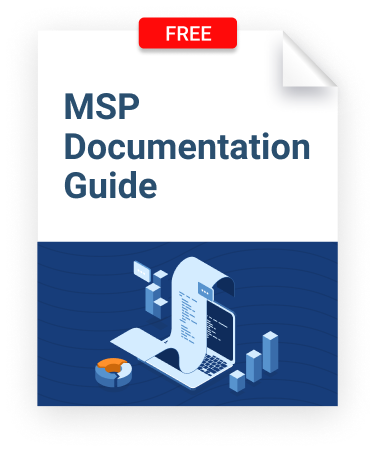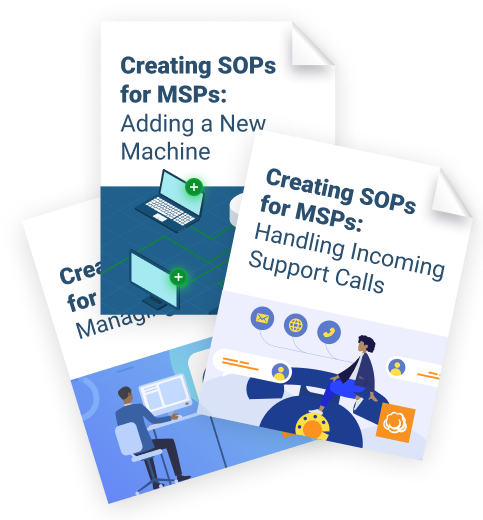Imagine that you employed the best tier-two staffer in the world. This person knows just about everything about your clients, can draw a network map for any of them with their eyes closed, standing on one leg in a dark room. And this perfect T2 is supportive – they will gladly teach any T1 you send them and share and spread their knowledge throughout your whole team. Now, let’s imagine the darkest of days, the day when this T2 leaves you, for whatever reason.
It might suddenly turn out that a huge chunk of your corporate knowledge about your customers relied on that one staffer. Of course, you have your remote monitoring and management tools installed and network maps drawn, but only that T2 knew the hidden faults in each of your clients' infrastructures. While this isn’t a tragedy, it will shake up your operations.
In short, it means that you should treat any knowledge as a resource that you must stock, preserve, polish, review and update. In this guide, we will discuss how to transform direct knowledge into such a resource, a training pool for your employees and a source of competitive advantage for you.
MSP Knowledge Management Benefits
Having planned, well-structured and documented knowledge management practices has a number of benefits for your managed IT business:
Evidence-based decisions. Since you have a central knowledge base, there is no room for decisions that are based on predictions, probability or just luck.
Ease of training. It will be easier to onboard new tech staffers of any level of expertise and teach them according to your standards.
Issues are solved faster. Sometimes it is indeed faster and easier to ask a more knowledgeable coworker about a customer issue. However, if that coworker is offline, you'd better have a knowledge base to make your support a faster and more reliable process.
Fewer faults due to standardized processes. Once you have standardized the basic processes and routine operations, such as password resets, new PC installations, and so on, the chances of your tech staffers making mistakes, for example installing the wrong piece of software at a customer site, decreases.
No need for reverse engineering. Remember when that best-in-the-world T2 left your company in our intro? Once that happened, if you hadn’t previously documented his or her knowledge, you'd have to get to your clients and collect the lost pieces of information about their infrastructures and typical issues.
Involves the team. Once your tech staffers figure out that they can help the whole company with their knowledge, they will become more motivated.
Further reading How Your Employees Can Contribute to Your MSP Business
A basis for end-user documentation. Great end-user documentation will not eliminate the need for your level-one support but it can reduce the number of basic support requests. This documentation is typically based on your knowledge base.

MSP Knowledge Management Processes
While the knowledge management concept may sound as if it belongs to the enterprise space, where a dozen technicians can document each and every procedure, a managed IT provider of any size can actually make use of it. There are a number of easy steps you should follow to do that:
Define the target. You cannot just “do some knowledge management”. It should be a distinctive target – creating new onboarding documents, a structural review of your customers’ network maps, or building a knowledge base for your staffers. Don't try to create all the required assets at once; you will most probably fail to control the amount of information, which can typically result in mistakes.
Choose the delivery method. A document that is created but not delivered to the target audience is useless. You should define whether you will use an internal wiki, a document-sharing solution, or whether a simple shared spreadsheet will be enough.
Collect data and get rid of outdated information. Now you need to prepare the documents themselves. If you are reviewing already-created documents, make sure that they are up-to-date.
Create a structure. Some procedures and checklists are interconnected and should be used together. So you should create an easy-to-follow structure that is clear for any user, whether internal or external.
Further reading How Checklists Can Power Your MSP Business
Review with the team. Remember, that your team is a source of knowledge -- oftentimes greater knowledge than yours.
Launch the assets. It's time to release the assets. Make sure they are delivered and the users understand how to work with them.
Review on a regular basis. Clear, concise, perfectly written but outdated assets are as good as useless. It is also a good practice to enlist an expert from your team to help you to review the documents and so reduce the chance of overlooking something or making mistakes.
Knowledge management is a systematic approach and should be embedded in, if not every organizational process, at least all the routines and scenarios you and your team typically encounter.
Further reading 7 Steps to Mastering SOPs
Creating a Knowledge Base
A knowledge base is a popular starting point for MSP knowledge management.
It is a localized resource containing all the information needed for your tech staffers to successfully accomplish just about any task, or to gather enough information to do it in the future. To put it simply, a knowledge base is a library, overviewing the support procedures, customer infrastructures, and how to work with the internal systems of your MSP. It can be solely internal or grow into an end-user knowledge base as well. Here are some top tips to create a knowledge base properly:
Categorize and structure. First of all, you should make sure that your future knowledge base is readable. Thus, you should plan its structure before you actually create the assets. Don't forget to embed search, tags, and a cross-linking structure to simplify navigation.
Use the appropriate document format. There's no format to fit every need, so pick the most appropriate for the job, whether it’s a flowchart, a script, a checklist or even a step-by-step video.
Update regularly. As we've already said, unless you want a useless collection of documents and assets, you should schedule regular reviews.
Use a solution. While not a must, a proper documenting solution will make your and your staffers’ lives easier. Here's a list of software that you can use.
Conclusion
As you can see, knowledge management is not merely a flashy marketing/enterprise buzzword. It has a lot to do with enhancing and streamlining the daily operations of a managed services provider of any size and structure. Once embedded, it may, and most probably will, become one of your hidden strengths, a quality that distinguishes an ordinary MSP from a great one.







